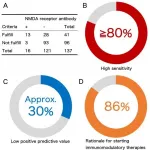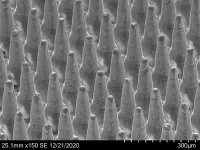(Press-News.org) Clinicians and scientists have long observed that cells in overstressed hearts have high levels of the simple sugar O-GlcNAc modifying thousands of proteins within cells. Now, researchers at Johns Hopkins Medicine have found evidence in mouse experiments that these excess sugars could well be a cause, not merely a consequence or marker of heart failure.
Their research found that elevated levels of O-GlcNAc made mice more prone to heart failure, but lowering levels of O-GlcNAc restored the animals' risk of death and heart function to normal. Together, the investigators say, the new findings, described online in the April 27th issue of the journal Circulation, could offer a potentially new molecular target for therapies that prevent or stop human heart failure.
According to the Centers for Disease Control and Prevention, an estimated 6.2 million Americans have heart failure, a progressive condition in which the heart struggles and ultimately fails to pump enough blood and oxygen to support the body's organs. The ailment costs the U.S. an estimated $30.7 billion in hospitalizations, treatment and lost productivity. Other conditions, including high blood pressure, diabetes and obesity contribute to the development of heart failure.
"Heart failure is a huge problem around the world, and our experiments show we may be able to move the therapeutic needle in the right direction by manipulating levels of O-GlcNAc," says Priya Umapathi, M.D., assistant professor of medicine at the Johns Hopkins University School of Medicine and first author of the new paper.
Proteins within living cells can be modified with the addition of small chemical groups that coax the proteins to change their shape or function. Among those modifications is O-GlcNAcylation, the addition of the sugar molecule O-GlcNAc (O-linked N-acetylglucosamine). The modification is controlled by two other molecules: O-GlcNAc transferase (OGT), an enzyme that adds the sugars to proteins, and O-GlcNAcase (OGA), an enzyme that facilitates their removal.
Researchers have long known that proteins in the cells of people with heart failure have more O-GlcNAc than usual. But whether increased levels of the sugar were a cause or consequence of heart failure -- or an attempt by the body to ward off heart failure -- has been unclear.
"The field has been conflicted about whether O-GlcNAc in the heart is a good thing or a bad thing," says Umapathi.
In the new work, Umapathi and her colleagues genetically engineered mice with higher than usual levels of OGT or OGA in heart muscle cells. The animals with high OGT -- and therefore more O-GlcNAc in these cells -- developed severe heart failure. Their hearts began to weaken and pump less blood at just 6 weeks old. By 25 weeks of age, more than half of all mice with high OGT had died, while no control animals with normal levels of OGT had died.
"These mice developed really stunning heart failure," says Umapathi. "Similar to many patients with cardiomyopathy, the mice developed enlarged hearts, abnormal electrical rhythms and died very early."
Animals with high OGA -- and therefore lower than usual O-GlcNAc in their heart cells -- remained healthy, however, and showed no signs of heart failure, even when challenged with an operation that constricts one of the heart's blood vessels.
To test whether high levels of O-GlcNAc could be reversed to help prevent end-stage heart failure, the researchers next cross-bred the two strains of mice, engineering animals to have both high OGT and OGA levels.
These animals no longer developed heart failure or died early, presumably because while OGT led them to add excessive O-GlcNAc sugars to proteins in the heart cells, the high levels of OGA reversed that excessive modification. That observation, the researchers say, suggests that drugs targeting the O-GlcNAc pathway could help prevent heart failure.
"Most existing heart failure therapies -- including beta-blockers, diuretics and ACE inhibitors -- target the same few molecular pathways," says Mark Anderson, M.D., Ph.D., professor and director of the Department of Medicine at Johns Hopkins University School of Medicine and an author of the new paper. "O-GlcNAc represents a completely new pathway that hasn't been targeted with therapeutics before, so that's really exciting."
In additional experiments, the team studied which proteins in heart cells were being modified with the addition of O-GlcNAc. Further studies along these same lines could reveal exactly why the sugars are so important and could possibly identify other molecules involved in heart failure.
"Now that we have these beautiful models to manipulate O-GlcNAc levels in the heart, we can start to get a much better understanding of how this modification plays a role in different subtypes of heart failure," says Natasha Zachara, Ph.D., associate professor of biological chemistry at the Institute for Basic Biomedical Sciences at Johns Hopkins University School of Medicine and a lead author of the new work.
INFORMATION:
In addition to Priya Umapathi, Natasha Zachara and Mark Anderson, other authors on the Circulation paper include Olurotimi Mesubi, Partha Banerjee, Neha Abrol, Qinchuan Wang, Elizabeth Luczak, Yuejin Wu, Jonathan Granger, Oscar Reyes Gaido, Liliana Florea and C. Conover Talbot Jr., of Johns Hopkins; An-Chi Wei of National Taiwan University; and Gerald Hart, of University of Georgia.
The research was supported by the National Institutes of Health under grants 1K12HL141952-01, P01HL107153, R01 HL139640 and R35 HL140034; Ministry of Science and Technology (Taiwan) grant MOST-107-2636-B-002-001; and American Heart Association Collaborative Science Award 17CSA33610107.
In a study conducted by researchers at Hospital for Special Surgery (HSS), cumulative opioid use was reduced by 30% in a patient group that received duloxetine after total knee arthroplasty (TKA) compared with patients who received placebo. Patients who received duloxetine also reported higher pain management satisfaction and less pain interference with mood, walking, normal sleep, and work activities. These findings were presented at the 2021 Spring American Society of Regional Anesthesia and Pain Medicine (ASRA) Annual Meeting.1
Studies have demonstrated that many patients report joint pain two weeks after ...
Millions of people suffer from psoriasis, a chronic, autoimmune disorder that causes scaly patches on the skin and often precedes psoriatic arthritis. While no cure exists, treatments range from topical creams to injected medications that block inflammation. To improve treatment options, scientists need to better understand the dysregulation of the immune system that leads to these lesions.
Using advanced computational genomic analysis of immune cells from mouse models, a researcher at the Pritzker School of Molecular Engineering (PME) at the University of Chicago and her collaborators ...
COLUMBIA, Mo. - When Ram Raghavan heard from a former colleague at the Centers for Disease Control and Prevention that a 7-year-old girl had died from Rocky Mountain spotted fever as the result of a tick bite, he thought of his own daughter, also 7 years old at the time, and the potentially fatal danger posed to vulnerable populations by tick-borne diseases.
Now a professor at the University of Missouri College of Veterinary Medicine and School of Health Professions, Raghavan is an epidemiologist studying how ticks, mosquitos and other arthropods spread disease that impact people, pets and livestock over time in various geographical regions.
In a recent study, the most comprehensive of its kind in the Midwest region of the United States, Raghavan and former graduate ...
Anti-NMDA receptor (NMDAR) encephalitis was first reported to develop in female young adults with ovarian teratoma. However, another study with a larger cohort reported that more than one-third of all patients with anti-NMDAR encephalitis were aged under 18 years, suggesting that this encephalitis might be more common in children than originally expected.
A clinical diagnostic approach to autoimmune encephalitis was proposed in 2016, and included diagnostic criteria for probable and definite anti-NMDAR encephalitis. For a diagnosis of probable anti-NMDAR encephalitis, the criteria require rapid onset ( END ...
Tokyo, Japan - Materials in a glassy state are everywhere in our lives and have contributed to humanity for many years. Today, they play a critical role in various technologies, including optical fibers. Although we believe that glass is highly stable, it sometimes crystallizes, resulting in loss of transparency and isotropy, essential characteristics of glass, which has been a significant problem in industrial applications. The reason why crystallization occurs in a solid-state with almost no molecular movement has been a great mystery. Its understanding may help to prevent or optimize crystal growth at deep supercooling.
In a study recently published in Nature Materials, researchers ...
A dengue virus vaccine candidate has passed an important milestone, with promising results in animal model testing providing hope to the 390 million people infected every year.
The University of Queensland-developed vaccine candidate, applied to the skin via the high-density microarray patch (HD-MAP), has produced a protective immune response in dengue-infected mice.
UQ PhD candidate Jovin Choo said the result could lead to a readily administered vaccine that could help halt the devastation of dengue fever globally.
"Dengue is the most significant mosquito-borne viral disease in the world's ...
LOS ALAMOS, N.M., May 12, 2021--A new theorem from the field of quantum machine learning has poked a major hole in the accepted understanding about information scrambling.
"Our theorem implies that we are not going to be able to use quantum machine learning to learn typical random or chaotic processes, such as black holes. In this sense, it places a fundamental limit on the learnability of unknown processes," said Zoe Holmes, a post-doc at Los Alamos National Laboratory and coauthor of the paper describing the work published today in Physical Review Letters.
"Thankfully, because most physically interesting processes are sufficiently simple or structured so that they do not resemble ...
A new study, by researchers from Simon Fraser University and the Department of Fisheries and Oceans, reveals the trade-offs of fish biodiversity--its costs and benefits to mixed-stock fisheries--and points to a potential way to harness the benefits while avoiding costs to fishery performance.
Many Pacific salmon fisheries catch fish that come from multiple stocks (management units), often representing locally-adapted populations, in so-called mixed-stock fisheries. Fish are intercepted in the ocean as they migrate along the coast, returning to different rivers to spawn.
The study used computer models of hypothetical fisheries and case studies of three actual sockeye salmon fisheries, including BC's Fraser River fishery, to explore how fish biodiversity within mixed-stock ...
PASADENA, Calif. -- Among cancer patients with health coverage in Southern California, those who were diagnosed and treated at Kaiser Permanente, an integrated health care organization, had better survival rates, especially Black and Latino patients, according to Kaiser Permanente research published in The American Journal of Managed Care.
"Kaiser Permanente is committed to finding and addressing health care inequities," said the study's senior author, Reina Haque, PhD, a cancer epidemiologist in the Kaiser Permanente Southern California Department of Research & Evaluation. "We investigated survival among insured patients with cancer ...
SAN FRANCISCO, CA--May 12, 2021--Following the minuscule movements of every cell in a petri dish would be a painstaking task for any human. But teach a set of computer programs to do the job, and they can complete it quickly and even observe things that the human eye would miss.
Scientists at Gladstone Institutes have developed such an approach, which uses "neural nets"--artificial intelligence programs that can detect patterns--to analyze the locations of hundreds of cells growing together in a colony. When they applied the technique to a group of stem cells, the program revealed that a small number of cells act as "leaders," able to direct the movements of their neighbors.
"This technique gives us a much more comprehensive view of how cells behave, how they work cooperatively, and how ...





